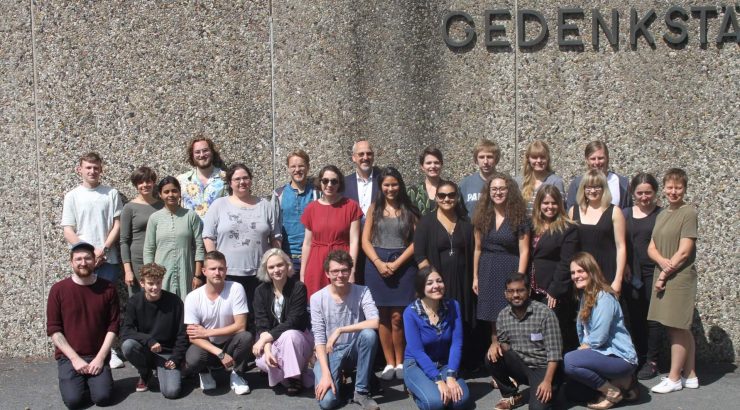Making the Past Present Transnational Memory and Bergen-Belsen
September 18, 2019
 Tiana Taliep is an Archivist for the Sala and Aron Samueli Holocaust Memorial Library and Archive at Chapman University since September 2017. Previously, she worked as a Processing Archivist at the New York Public Library. Tiana earned her B.A. in History from Brooklyn College, and Master’s in Library and Information Science with a certification in Archives and Preservation of Cultural Material from Queens College. She is a second-year student in the War and Society Mater’s program at Chapman University.
Tiana Taliep is an Archivist for the Sala and Aron Samueli Holocaust Memorial Library and Archive at Chapman University since September 2017. Previously, she worked as a Processing Archivist at the New York Public Library. Tiana earned her B.A. in History from Brooklyn College, and Master’s in Library and Information Science with a certification in Archives and Preservation of Cultural Material from Queens College. She is a second-year student in the War and Society Mater’s program at Chapman University.

This summer I was privileged to be one of 20 participants from over 400 applicants to attend the Sixth International Summer School at the former concentration camp of Bergen-Belsen. Liberated by the British in April 1945, the camp is perhaps best known as the site where Anne Frank and her sister Margot died only a few weeks before.
As the events of the Holocaust become more distant with fewer and fewer survivors to witness at first hand to what occurred, the staff of the Bergen-Belsen Memorial is developing new ways of remembering, researching and teaching the camp’s history. A vital component of this project is educating professionals at the beginnings of their careers who are engaged in Holocaust, genocide and memory studies. Attending this international seminar with representatives from 18 countries was both intellectually enriching and emotionally draining as I reflected on the tens of thousands of individuals whose lives had ended here.
Participants in the seminar came from various disciplines and included academics and staff from museums and memorials. The focus of this year’s program was on transnational memory and global memory culture in the digital age. Our shared objective was to conceptualize transnational memory and its influence on the way we remember and teach the Holocaust and other mass atrocities.
 The Bergen-Belsen Memorial, founded in 1952, is the oldest national memorial to the Holocaust in Germany. The camp itself was established early in the war by the Wehrmacht (army) as a camp for Belgian and French prisoners of war and then expanded after July 1941 to include Soviet POWS. In 1943, a section of the camp was taken over by the SS as a concentration camp for Jews. After the British liberated the camp, they established an emergency hospital in the nearby Wehrmacht barracks. This site was eventually expanded into two sections housing Polish and Jewish displaced person. It eventually became the largest Jewish displaced persons camp in Germany. At its height, it housed as many as 12,000 survivors. It closed in 1950.
The Bergen-Belsen Memorial, founded in 1952, is the oldest national memorial to the Holocaust in Germany. The camp itself was established early in the war by the Wehrmacht (army) as a camp for Belgian and French prisoners of war and then expanded after July 1941 to include Soviet POWS. In 1943, a section of the camp was taken over by the SS as a concentration camp for Jews. After the British liberated the camp, they established an emergency hospital in the nearby Wehrmacht barracks. This site was eventually expanded into two sections housing Polish and Jewish displaced person. It eventually became the largest Jewish displaced persons camp in Germany. At its height, it housed as many as 12,000 survivors. It closed in 1950.
Over the course of two very intensive weeks, my fellow participants and I attended workshops, seminars, group projects, individual presentations, and guided tours. Some of the workshops we attended included Actors of Transnational Memory, Popular Culture as Transnational Memory, and Local Perspectives on Holocaust Memory. We discussed and debated what memory is and what forms it takes, how we remember the Holocaust, and how the memory of the Holocaust is conveyed in popular culture through movies, social media, art, literature, and advertising. We met in small sessions with Bergen-Belsen staff members who shared with us their current projects and future goals.
 We also explored the grounds of the former that now displays few visible remains of its Nazi history. By using a tablet application that overlays the landscape, we were able to identify where various buildings had once stood. We spent many hours visiting the Memorial’s permanent exhibition that documents the various phases of Bergen-Belsen: the Wehrmacht POW Camp, the concentration camp, and the displaced persons camp, as well as the post-war prosecution of Nazi perpetrators. The exhibition relies heavily on artifacts, including photographs, documents, correspondence, and textiles, augmented by the oral testimonies of survivors. We spent a day visiting the Niedersachsen barracks, which was the former Wehrmacht base that British soldiers transformed into an emergency hospital. We also walked among the gravestones in the cemetery, including the symbolic gravestone for Anne and Margot Frank. I found that to be a particularly moving and memorable experience.
We also explored the grounds of the former that now displays few visible remains of its Nazi history. By using a tablet application that overlays the landscape, we were able to identify where various buildings had once stood. We spent many hours visiting the Memorial’s permanent exhibition that documents the various phases of Bergen-Belsen: the Wehrmacht POW Camp, the concentration camp, and the displaced persons camp, as well as the post-war prosecution of Nazi perpetrators. The exhibition relies heavily on artifacts, including photographs, documents, correspondence, and textiles, augmented by the oral testimonies of survivors. We spent a day visiting the Niedersachsen barracks, which was the former Wehrmacht base that British soldiers transformed into an emergency hospital. We also walked among the gravestones in the cemetery, including the symbolic gravestone for Anne and Margot Frank. I found that to be a particularly moving and memorable experience.
This year summer school participants had a unique opportunity to contribute to the 2020 ceremony which will mark the 75th anniversary of the liberation of Bergen-Belsen. We selected locations around the site to record ourselves sharing our thoughts on memory, thereby contributing to the Bergen-Belsen Memorial’s emphasis on transnational, collectible memory that transcends the boundaries of the camp itself. In a wooded area near the boundary of the former camp, I shared my reflections on memory, and especially on my obligation as an archivist to respect the collected memories of individuals represented within a finding aid. The Bergen-Belsen International Summer School was an exceptional opportunity to learn both from experts and from my fellow participants who came from so many different backgrounds and countries. It was a once in a lifetime opportunity for us as a group of young professionals to grapple with the complex question of how we can work more effectively to sustain and further Holocaust memory in the decades to come.
